The Olmo Ling Humla Project
Humla, Nepal | A Place of Vast Cultural and Natural Beauty
Click HERE for budget details or to support our work with a donation
About Humla
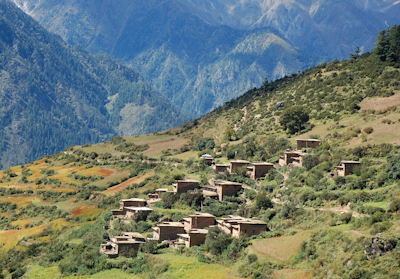
Torpa Village, Tempa Lama’s home village in Humla.
The Humla Valley, Tempa Lama’s home region, is a land of incredible natural beauty and rich cultural traditions. Tucked into the mountains in Nepal’s Northwest, the Humla district is one of the world’s most remote areas.
Humla is located in Karnali Province. It borders Tibet to the north in close proximity to the sacred sites of Mount Kailash and Lake Manasarovar. Many families in Humla have been deeply rooted in the Bon faith and Bon practice for many generations. Humla is also home to Tibetan Buddhist and Hindu practitioners and Shamanic lineages that continue today. Tempa Lama’s grandfather was a village shaman priest or Drang Rig. These shamans traditionally help villagers for health and prosperity.
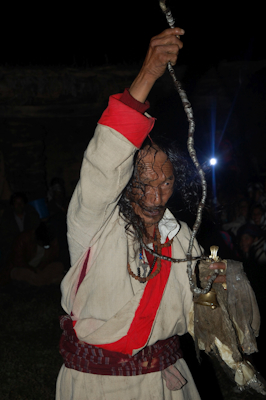
Shaman Pama, a Shaman Priest or
Drang Rig.
In the Bon tradition, Mount Kailash is viewed as the center of the universe – the soul mountain for the ancient kingdom of Zhang Zhung, where Bon originated. Mt. Kailash is the citadel of the celestial deity Gekhöd, the protector deity of Zhang Zhung. The area surrounding this sacred mountain is home to many Bon yogis and yoginis who live in long-term retreat. Nearby Lake Manasarovar is one of the most sacred lakes in Tibet, revered by Bon, Buddhist, and Hindu people alike. Stepping on the shore and taking a bath in the sacred Lake Manasarovar or drinking from its water is believed to purify the karma of a hundred lifetimes.
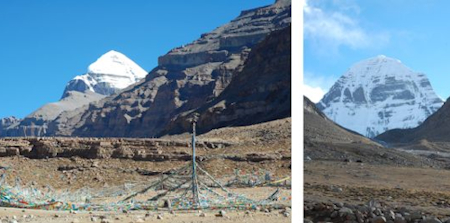
Mount Kaliash, Tibet
Humla’s approximately 50,000 inhabitants are spread out across small villages in lower, middle, and upper Humla. About 11,000 people live in the capital of Simikot. The traditional lifestyle is semi-nomadic around yak, sheep, and goat herding. The Humli people traditionally used sheep to carry salt on the Himalayan salt trading route with Nepal. During the short growing season, different varieties of millet, buckwheat, and barley and some vegetables are grown and stored for winter.
With Humla being so remote and lacking in resources, there is little access to medical care. Most homes outside of Simikot do not have access to electricity or running water. The Humla valley can only be accessed on foot and via the small mountain airport that is visited weather-permitting by small aircraft from Nepalgunj. In recent years, tourism has grown, including by pilgrims on the 5-6 day mountain trek to Mt. Kailash.

Tempa Lama’s vision for a Sustainable Future for Humla
Guided by Tempa Lama’s vision and close coordination with village elders, our work in Humla encompasses four dimensions:
- Strengthening and preserving Humla’s traditional Bon religion and culture, Shamanic heritage, and unique mountain ecology and
- Broadening access to quality education and instruction in Tibetan language and culture in schools
- Broadening access to traditional Tibetan and Western medicine and healthcare and raising awareness of the importance of traditional medicine
- Identifying and supporting opportunities for sustainable livelihoods for the people of Humla.
Our work in these four areas is described below.
Bon Cultural Society of Humla
Founded in 2001 by Tempa Lama, the Bon Cultural Society is our main partner for our work of supporting the Humli people during this transition. The Bon Cultural Society is overseen by village elders and is dedicated to better understanding the needs of the people of Humla and empowering villagers to address these needs and create their own future.
Pilgrimage and Medical Service Trips to Humla
Tempa Lama has 25 years experience leading and co-leading pilgrimage trips to Tibet, Nepal and India (Menri Monastery) as well as medical service trips to Humla, Nepal. Following a medical service trip offered by Olmo Ling in 2014, Tempa Lama led annual medical service trips under the auspices of Humla Fund during 2014 to 2018. Through these trips we have been able to offer free healthcare and treatments to hundreds of people in different villages.
In fall 2025, Tempa Lama and his brother Geshe Tsewang Ngodup Rinpoche will be offering a 24-day pilgrimage trip from the Humla valley to Mount Kailash and Lake Manasarowar in Tibet.This special pilgrimage will include daily teachings, meditation and Bon rituals with Tempa Lama and Geshe Tsewang Ngodup Rinpoche. Click here to read more and view the pilgrimage itinerary.
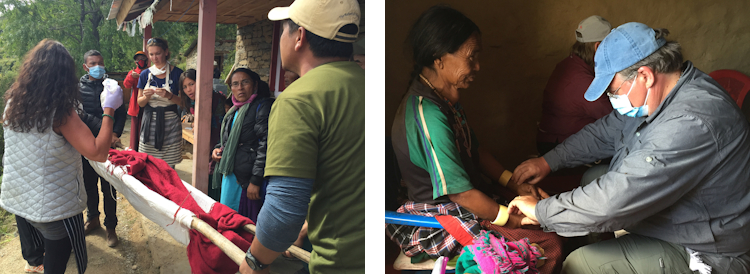
Annual Medical Trips made to Humla from 2014 – 2018. Right: Tim Aitken, LAc. offering treatment

Bon Temple and Monastery Pal Samten Due Dul Wosel Ling
Pal Samten Due Dul Wosel Ling temple is housed jointly with the traditional clinic Sorig Tenpe Menkhang in a new building that was constructed with Tempa Lama’s guidance during 2017-18 outside Simikot. On March 8th, 2023, the auspicious birth anniversary of Buddha Tonpa Shenrab, Geshe Tsewang Ngodup was enthroned as the abbot of Pal Samten Due Dul Wosel Ling with the blessing of His Holiness 34th Menri Trizin Rinpoche.
The Humla valley is deeply connected with the Zhang Zhung Bon religion and culture and the teachings of the Awakened One and founder of Bon, Tonpa Shenrab. People in Humla have practiced Bon rituals and meditation for a long time. However, there is no Bon monastery or Bon learning center in Humla. Therefore the Bon tradition in Humla has almost disappeared. Over the centuries we have lost many of the cultural and religious traditions and the unique identity of Bon practice. Our goal in establishing a temple in Humla is to restore this ancient tradition and to provide what people are looking for – to have access to authentic Bon rituals and teachings.
In the remote villages of the Trans-himalayan region, people believe in the ancient traditions of Bon practice, including healing, ritual, and divination. Now many centuries later we have a highly trained Bon Geshe who is a Humla native and who wants to serve his home region. As the abbot of Pal Samten Due Dul Wosel Ling Temple Geshe Tsewang Ngodup will be able to serve the Humli people by offering prayers and rituals and in particular training lay people in doing rituals and prayers themselves and spending time in retreat. In this way people will be able to continue and revive the ancient tradition and lineage.

Health care and access to traditional Tibetan medicine
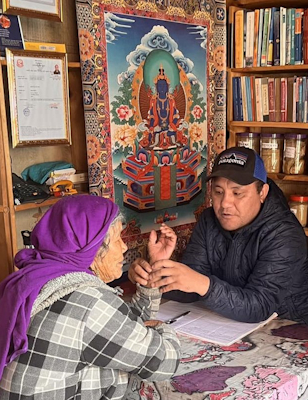
Tibetan Doctor Amchi Tsering seeing a patient.
Amchi Tsering’s medical education was sponsored by Olmo Ling. By paying Amchi Tsering’s monthly salary, clinic upkeep, and medical supplies, we are able to offer free care to villagers. Demand for healthcare has been high and we hope to be able to add a second Amchi (traditional doctor) in 2025.
The work of Sorig Tenpe Menkhang is critical for preserving native medical practices and bringing awareness of their importance to Humla’s youth. In 2022 the Karnali Province government recognized Sorig Tenpe Menkhang as an important center of Tibetan medicine. Read more about the clinic HERE.
In addition to the work at the clinic, we are responsive to short-term medical needs. In 2021 we raised $25,940 to provide urgently needed medical equipment to protect the people of Humla from the COVID pandemic. We were able to sponsor an oxygen concentrator, ventilators, hospital beds with monitors, oxygen masks, essential medicines, and protective equipment. Read more about this work HERE.
Restoration of traditional temples
With the help of Humla Fund, Tempa Lama has restored several traditional temples across several villages. He also built one new temple:
- Restoration of the main Shaman Temple and Women’s Shaman temple in Torpa village
- Restoration of the Shaman temple in Baranshe village
- Restoration of the Shaman temple in Nyimatang village
- Restoration of the Shaman temple in Bargaun village
- Restoration of the Four Direction Protectors’ Stupa in Bargaun village
- Construction of a new Prayer Wheel Temple in Nyimatang village

Left: Shaman Temple, Right: Prayer Wheel Temple built by Tempa Lama and Humla Fund in 2014.
Education and Vocational Training
Olmo Ling is also sponsoring children and supporting families to enable children to attend school. Children are typically either semi-orphans or from poor families. In addition, we have sponsored vocational training for several young Humli natives, including a radiologist, a carpenter, and a dentist.
Humla Project Update – 2025
Thank you so much for your generous support. With your help we have been able to sponsor all the necessary ritual items, 3 large statues, and 8 Thangkas for Pal Samten Due Dul Wosel Ling Bon Temple!We are most grateful for a generous $20,000 gift from Tim Aitken, LAc., that enabled us to commission three beautifully crafted 24” altar statues of Tonpa Shenrab, Sherab Jamma, and Sidpa Gyalmo and to Dr. Linda Wellner for a $10,000 gift enabling us to construct the altar and torma shelving. We still need to pay for the altar painting and a few other small items.
The yearly budget for Sorig Tenpa’i Menkhang Clinic includes:
- Salary for one senior Amchi (Tibetan Doctor) and one younger Amchi
- Building Caretaker
- Maintenance & Repair
- Government and Audit Fees
- Medical supplies
Support our work in Humla!
Donate via PayPal or set up a recurring donation via Paypal
Please note that PayPal allows you to elect to either make a one-time donation or give monthly or annually
Donate via Check
Please write the check to Olmo Ling with a note “Humla Project” and send it to Olmo Ling, 1101 Greenfield Ave, Pittsburgh, PA 15217.
Donate via Credit Card


